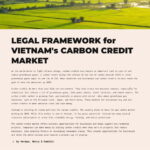To read or download the article, please click the following link.
WHAT TO KEEP IN MIND WHEN INVESTING IN VIETNAM
I. VIETNAM’S TAXATION SYSTEM
1. Corporate Income Tax (CIT)
Vietnam’s Corporate Income Tax (CIT) is a central component of its tax system, levied on the profits of enterprises. The standard CIT rate is 20%, applicable to most businesses across various sectors, including both local and foreign enterprises operating in Vietnam. However, specific industries such as oil, gas, and mineral extraction are subject to higher rates, ranging from 25% to 50% depending on the nature and profitability of the activity.
2. Value-Added Tax (VAT)
VAT is a consumption tax levied on the sale of goods and services in Vietnam, with standard rates of 0%, 5%, and 10%. The standard rate of 10% applies to most goods and services, while the 5% rate is for essential goods and services such as healthcare and education. Goods exported from Vietnam are typically subject to a 0% VAT rate, incentivizing international trade.
Value-Added Tax (VAT) in Vietnam has undergone significant changes aimed at supporting economic recovery and stimulating consumption.
As of January 1, 2024, the standard VAT rate was reduced from 10% to 8% for most goods and services. This reduction is part of a broader strategy to bolster economic activity amid ongoing global uncertainties and challenges posed by the post-COVID-19 economic environment. Initially, the reduced VAT rate of 8% was applicable until June 30, 2024. However, recent resolutions have extended this reduced rate until the end of 2024.
3. Tax on Foreign Entities
Foreign investors in Vietnam are subject to several taxes, including CIT, VAT, and Foreign Contractor Tax (FCT). FCT applies to foreign entities earning income in Vietnam without a permanent establishment in the country. It combines CIT and VAT components and is typically withheld by the Vietnamese contracting party at rates varying between 5% and 10% depending on the nature of the service provided.
4. Transfer Pricing Regulations
Vietnam has stringent transfer pricing regulations to prevent base erosion and profit shifting (BEPS). These regulations require related-party transactions to be conducted at arm’s length, and enterprises must submit annual transfer pricing documentation to demonstrate compliance. Vietnam also follows the OECD’s guidelines on transfer pricing and has adopted the global minimum tax regime under BEPS 2.0, imposing a minimum effective tax rate of 15% on large multinational enterprises.
5. Tax Incentives
Vietnam offers several tax incentives to attract foreign investment, particularly in high-tech sectors, agriculture and renewable energy sectors, economic zones, or regions with difficult socio-economic conditions. These incentives include tax holidays, reduced tax rates, and exemptions.
For example, enterprises investing in high-tech zones or in economically disadvantaged areas may enjoy a CIT rate as low as 10% for up to 15 years, a four-year tax exemption, and a 50% tax reduction for the subsequent nine years.
6. Other Relevant Taxes
- Personal Income Tax (PIT): Applied to individuals’ income at progressive rates from 5% to 35%. Foreign individuals are subject to PIT based on their tax residency status.
- Special Consumption Tax (SCT): Levied on the production or importation of specific goods such as tobacco, alcohol, and automobiles.
- Import and Export Duties: These duties apply to goods entering or leaving Vietnam, with specific exemptions for goods in transit, items in non-tariff zones, and goods exported from non-tariff areas to foreign countries.
7. Compliance and Reporting
Businesses must adhere to rigorous tax compliance requirements in Vietnam, including monthly, quarterly, and annual tax filings. The deadlines for tax submissions vary based on the type of tax and the fiscal year of the enterprise. It is essential for businesses to stay updated with the latest tax regulations and seek professional advice to ensure compliance and optimize tax liabilities.
II. INTELLECTUAL PROPERTY LAW IN VIETNAM:
1. Definition and Scope of Intellectual Property
Intellectual Property in Vietnam encompasses various forms of creations and inventions. The law recognizes and protects the following key categories:
- Trademarks: Defined as any sign used to distinguish goods or services of different organizations or individuals. This includes collective marks, certification marks, well-known marks, and integrated marks.
- Patents: Cover inventions, useful solutions to technical problems, and industrial designs, including partial designs as per the latest amendment.
- Copyrights: Protect literary, artistic, and scientific works, including moral and economic rights.
- Geographical Indications: Signs identifying products as originating from specific regions, known for certain qualities or reputation.
- Trade Secrets: Information from financial or intellectual investment that remains undisclosed and can be used in business.
- Plant Varieties: Groupings within a single botanical taxon, uniform and stable in propagation.
2. Vietnam’s Participation in International Conventions
Vietnam is a member of several international IP conventions, including:
- The Paris Convention for the Protection of Industrial Property
- The Berne Convention for the Protection of Literary and Artistic Works
- The Rome Convention
- The Trade-Related Aspects of Intellectual Property Rights (TRIPS) Agreement
- The World Intellectual Property Organization (WIPO)
- The Patent Cooperation Treaty (PCT)
- The Madrid Protocol
- The Hague Agreement
These memberships ensure that Vietnam’s IP laws are consistent with global standards.
3. IP Registration Procedures
a) Copyrights
Copyrights in Vietnam are governed by the Berne Convention, which provides automatic protection without the need for registration. However, it is advisable to register your works with the National Copyright Office to strengthen your legal position in enforcement actions.
b) Patents
Vietnam operates under a “first to file” system. Patents are categorized into:
- Invention Patents: Protected for up to 20 years.
- Utility Solution Patents: Protected for up to 10 years.
- Industrial Designs: Protected for an initial five-year period, renewable for two consecutive periods of five years each.
Applications must be filed with the National Office of Intellectual Property (NOIP). The PCT can facilitate patent applications that extend beyond Vietnam.
c) Trademarks
Trademarks in Vietnam cover symbols, three-dimensional objects, colors, and other visual devices identifying goods or services. Trademarks are valid for 10 years and can be renewed indefinitely. Registration is handled by NOIP and can take up to 15 months to complete. The Madrid Protocol can be used for international trademark registration.
4. Enforcement of IP Rights
IP rights in Vietnam can be enforced through three primary avenues:
- Administrative Action: Involves government agencies issuing warnings, fines, and ordering the seizure or destruction of counterfeit goods.
- Civil Court Action: Allows IP holders to seek damages and injunctive relief through the court system.
- Criminal Prosecution: In severe cases, IP infringement can lead to criminal penalties, including imprisonment.
Most IP disputes in Vietnam are resolved through administrative actions due to their relative speed and efficiency.
5. Practical Strategies for Protecting IP
Defensive Measures
- Employment Contracts: Ensure that contracts include clear IP-related clauses to prevent unauthorized use of IP by employees.
- Monitoring and Auditing: Regularly monitor production processes to detect any signs of overproduction that might indicate counterfeiting.
- Registering IP: Proactively register all forms of IP to ensure legal protection and facilitate enforcement actions.
III. VIETNAM’S LABOR LAW
1. Employment Contracts
Vietnamese labor law mandates written employment contracts for all employment relationships. These contracts can be of two types:
- Indefinite-term contracts: No fixed duration for the employment relationship.
- Fixed-term contracts: Duration of up to 36 months, renewable once. If the contract is not renewed within 30 days after expiry, it automatically converts to an indefinite-term contract.
2. Working Hours and Overtime
The standard workweek in Vietnam is capped at 48 hours, with a maximum of eight hours per day. Overtime is permissible but regulated, not to exceed 200 hours per year generally, and 300 hours for specific industries. Employers and employees can mutually agree on overtime, but it must comply with legal limitations.
3. Minimum Wage and Social Insurance
The minimum wage in Vietnam varies by region, reflecting the cost of living disparities. As of 2023, it ranges from VND 3,070,000 to VND 4,420,000 per month. Employers are required to contribute to social insurance, health insurance, and unemployment insurance, totaling approximately 17.5% of the employee’s salary, while Employees will have to pay approximately an eight percent rate,.
4. Hiring Foreign Employees
Hiring foreign workers in Vietnam is subject to a stringent set of regulations. Key points include:
- Work Permits: Foreign employees must obtain work permits, with the process requiring the employer to demonstrate that the position cannot be filled by a local worker. This application must be submitted at least 15 days before the commencement of employment.
- Qualification Requirements: The definitions of “experts” and “technical workers” are strictly defined. For instance, experts need a university degree and at least three years of experience in the relevant field.
- Approval Process: The Ministry of Labor, War Invalids, and Social Affairs (MoLISA) oversees the approval process. Recent updates have simplified some requirements, such as reducing the advance notice period from 30 days to 15 days and relaxing the degree relevance requirements.
5. Philosophy of Labor Law in Vietnam
Vietnam’s labor law is rooted in a philosophy aimed at protecting the labor class, reflecting the country’s socio-political framework. This protective stance significantly influences various aspects of labor regulations, particularly in terms of employee termination. In contrast, labor laws in other countries often balance between protecting employee rights and providing flexibility to employers. This article delves into the unique features of Vietnam’s labor law compared to those of other countries, highlighting the protective nature of its regulations and the challenges it poses for employers.
The key aspects include:
- Difficult Termination Procedures: Terminating an employee in Vietnam involves a complex and often lengthy process. Employers must follow strict protocols, including valid grounds for dismissal, written notice, and in many cases, consultation with trade unions.
- Comprehensive Employee Rights: The labor law mandates numerous protections for employees, including detailed provisions on working hours, overtime, minimum wage, social insurance, and more. These regulations aim to ensure fair treatment and adequate compensation for workers.
- Emphasis on Job Security: Vietnam’s labor law places a strong emphasis on job security, making it difficult for employers to unilaterally terminate employment contracts. This is designed to provide workers with a stable employment environment.
IV. FOREIGN INVESTMENT IN VIETNAM’S REAL ESTATE SECTOR
1. Land Ownership and Use Rights
In Vietnam, land is collectively owned by the state, and individuals or entities, including foreign investors, can only acquire land use rights (LURs). These rights are typically granted through leases rather than outright purchases. The primary laws governing land use and real estate transactions for foreign investors include the Land Law, the Law on Real Estate Business, and the Housing Law.
2. Investment Opportunities By Sector
a) Industrial Parks
Vietnam’s industrial parks are strategically located in economic zones, offering significant opportunities for manufacturing and logistics investments. The Northern Economic Zone, including Hanoi and Hai Phong, is a key hub for manufacturing and infrastructure development, while the Southern Economic Zone, encompassing Ho Chi Minh City, is a major commercial center attracting substantial foreign investment.
Key Considerations:
- Infrastructure Development: Industrial parks often come with developed infrastructure, reducing initial investment costs.
- Government Incentives: Various incentives, including tax breaks and reduced land lease rates, are available to attract foreign investment.
b) Hotels and Tourism
The tourism sector in Vietnam is booming, with cities like Da Nang, Nha Trang, and Phu Quoc becoming popular tourist destinations. Foreign investors can invest in hotel projects either by leasing land or acquiring properties with LURs.
Key Considerations:
- Location Appeal: Prime tourist locations offer higher returns due to steady tourist inflows.
- Regulatory Compliance: Adhering to zoning laws and obtaining necessary permits is crucial.
c) Office Buildings
Ho Chi Minh City and Hanoi are the primary locations for office buildings, catering to the growing demand from multinational corporations and local businesses. Foreign investors can purchase office spaces within these buildings or lease land to develop commercial properties.
Key Considerations:
- Market Demand: High demand for office space in central business districts ensures steady rental income.
- Legal Procedures: Investors must navigate complex legal procedures to secure land use rights and construction permits.
d) Condominiums
The condominium market in Vietnam is attractive due to the country’s rapid urbanization and increasing middle-class population. Foreign investors can purchase condominium units within permitted limits.
Key Considerations:
- Ownership Limits: Foreign investors can own up to 30% of the total units in a condominium project.
- Certification: Obtaining a certificate of land use rights and ownership of the property (Pink Book) is essential.
V. HOW FOREIGN INVESTORS CAN PROFIT FROM BUSINESSES IN VIETNAM
1. Profiting Through Dividends
Eligibility and Declaration: Foreign investors can receive dividends from their investments in Vietnamese companies, provided the company has positive retained earnings and is not in a loss position. The financial statements must be audited and submitted to the relevant authorities. All taxes and financial obligations to the Vietnamese government must be fully settled before dividends can be declared and paid.
Payment Process: Once dividends are declared, the local tax authority must be notified. They have seven days to object to the payment. If no objection is raised, the payment can proceed. Dividends must be paid through a Direct Investment Capital Account (DICA) for companies or an Indirect Investment Capital Account (IICA) for individuals. It’s crucial to liaise with the bank to ensure all required documents are prepared, including those necessary for currency conversion from Vietnamese Dong (VND) to foreign currency.
2. Profiting Through Business Sales
Capital Gains: Foreign investors can also profit by selling their stakes in Vietnamese businesses. A new draft CIT law was released proposing to tax the transfer of capital at 2% on gross sales proceeds (not dependent on gain/loss position) applied for both direct and indirect share transfers.
Transfer of Capital: Upon selling their business, investors can transfer the proceeds abroad after fulfilling all financial obligations, including paying any applicable taxes. The process involves submitting audited financial statements and tax declarations, and notifying the tax authority of the intended transfer.
3. Procedures for Transferring Profits Abroad: Challenges and Realities
Transferring money abroad from Vietnam is a complex and tightly regulated process, reflecting the government’s stringent foreign exchange control policies. While the laws theoretically allow for certain types of remittances, in practice, navigating these regulations can be daunting.
a) The Process of Profit Transfer
- Financial Review and Documentation:
- The company must ensure its financial statements are audited and taxes are fully paid.
- A profit allocation must be approved by the board or the members’ council, detailing the amount and type of profit to be remitted.
- Notification and Approval:
- The enterprise must notify the local tax authority of the intended profit transfer. This notice includes providing all necessary documentation to demonstrate compliance with financial obligations.
- There is a seven-day waiting period during which the tax authority can object to the profit transfer.
- Banking Procedures:
- Profits must be transferred through a registered credit institution, typically involving the conversion of Vietnamese Dong (VND) to foreign currency.
- The entire remittance process should be completed within 30 working days from the date of currency conversion.
b) Practical Challenges
Despite the clear legal guidelines, transferring money out of Vietnam remains a significant challenge. The primary hurdles include bureaucratic procedures, stringent documentation requirements, and the discretionary power of banks to approve or deny transactions.
- Bureaucratic Procedures: The process involves multiple steps, including obtaining approvals from relevant authorities and complying with detailed documentation requirements. These procedures can be time-consuming and often require meticulous preparation of documents to satisfy regulatory scrutiny.
- Documentation Requirements: For each type of permissible transfer, specific documents must be provided. These documents must be submitted to and verified by licensed banks, which adds another layer of complexity.
- Discretionary Bank Approval: Even when all documentation is in order, banks have considerable discretion in approving transfers. This discretionary power can result in inconsistent application of regulations, with some transfers being approved and others denied without clear reasons.







